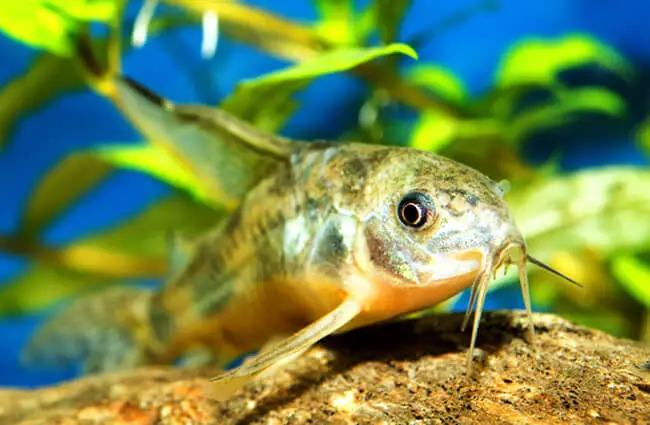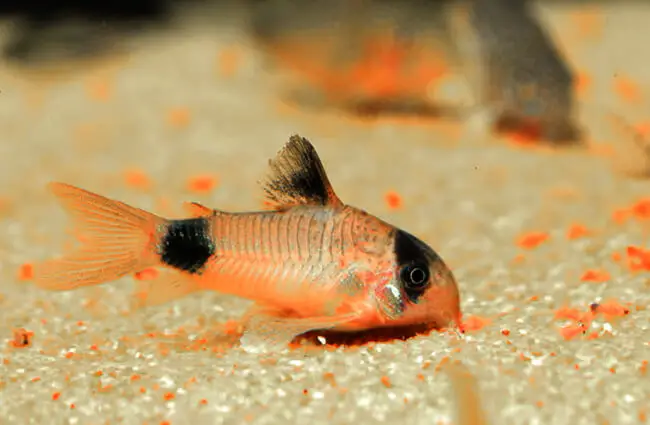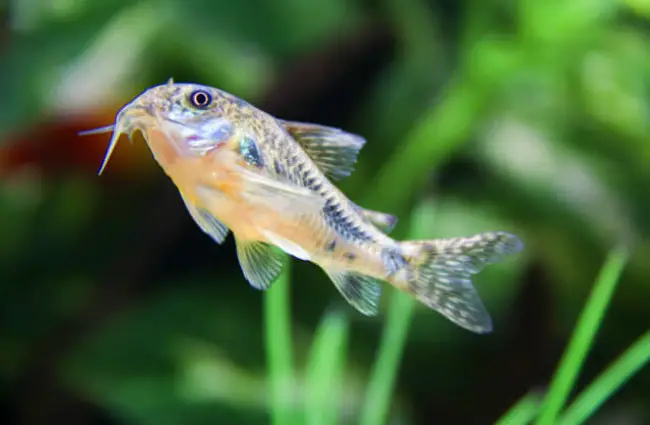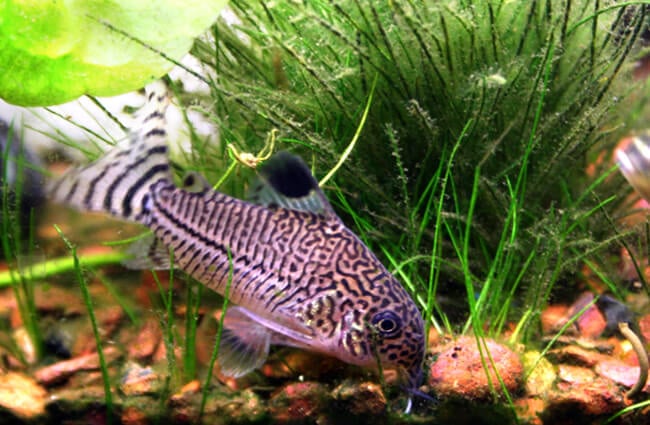Deep within the intricate waterways of South America, a captivating group of fish thrives, charming observers with their industrious nature and distinctive appearance. These are the Cory Catfish, often affectionately known as “Corys,” a diverse genus of armored bottom-dwellers that have captured the hearts of aquarists and scientists alike. Far more than just tank cleaners, these small, peaceful fish play a vital role in their ecosystems and offer a fascinating study in adaptation and social behavior.
From the bustling rivers to the tranquil streams, Cory Catfish navigate their world with an endearing blend of curiosity and resilience. Their unique adaptations, from their sensitive barbels to their protective bony plates, tell a story of survival and evolution in dynamic freshwater environments. Join an exploration into the world of these remarkable fish, uncovering their secrets from their ancient lineage to their complex interactions with both nature and humanity.

The Charming World of Cory Catfish: An Aquatic Marvel
What Exactly is a Cory Catfish?
Cory Catfish belong to the genus Corydoras, part of the family Callichthyidae, commonly known as armored catfish. These small freshwater fish typically range from one to four inches in length, depending on the species. Their most striking feature is their body armor, composed of two rows of overlapping bony plates, or scutes, running along their flanks, providing excellent protection against predators. Unlike many fish, they lack scales. A distinctive characteristic is the presence of sensitive barbels around their mouths, which they use to forage for food in the substrate. With over 160 described species and many more awaiting classification, Corys exhibit a wide array of colors and patterns, from the metallic sheen of the Bronze Cory (*Corydoras aeneus*) to the intricate spots of the Julii Cory (*Corydoras julii*) and the speckled camouflage of the Peppered Cory (*Corydoras paleatus*).
A Glimpse into Their Natural Habitat
The natural range of Cory Catfish spans across South America, from the foothills of the Andes to the vast Amazon basin and beyond. They are found in a variety of freshwater environments, including slow-moving rivers, streams, tributaries, ponds, and even flooded forest areas. These habitats are typically characterized by soft, sandy, or muddy substrates, often littered with leaf litter, submerged roots, and driftwood. Corys prefer shallow waters with dense vegetation, which provides both cover from predators and rich foraging grounds. The water conditions in their native environments are generally soft to moderately hard, with a slightly acidic to neutral pH, and temperatures ranging from 72 to 79 degrees Fahrenheit (22-26 degrees Celsius). Their ability to adapt to varying conditions within these parameters highlights their resilience.

Life Beneath the Surface: Behavior and Ecology
Social Butterflies of the Riverbed
Cory Catfish are renowned for their peaceful and highly social nature. They are schooling fish, meaning they thrive in groups of their own kind. Observing a shoal of Corys diligently sifting through the substrate, often in unison, is a testament to their communal spirit. This schooling behavior offers protection against predators, as there is safety in numbers. They are primarily diurnal, actively foraging during the day, though some species may exhibit crepuscular activity. Their constant activity at the bottom of their habitat, combined with their gentle demeanor, makes them fascinating subjects for observation. They rarely show aggression towards other fish species, making them ideal community dwellers in both the wild and captivity.
The Diet of a Dedicated Detritivore
As quintessential bottom feeders, Cory Catfish play a crucial role as detritivores in their ecosystems. Their diet in the wild consists primarily of small invertebrates such as worms, insect larvae, and crustaceans, along with decaying plant matter and other organic detritus found in the substrate. They use their sensitive barbels to probe and sift through sand and mud, detecting food particles that other fish might miss. This foraging behavior helps to aerate the substrate and break down organic material, contributing to the overall health of the aquatic environment. In essence, Corys act as the clean-up crew of the riverbed, recycling nutrients and preventing the build-up of decaying matter.

Armored for Survival: Evolutionary Insights
The evolutionary history of Cory Catfish is deeply rooted in the ancient freshwater systems of South America. As members of the Callichthyidae family, they represent a lineage of armored catfish that have successfully adapted to diverse aquatic conditions over millions of years. Their most distinctive evolutionary adaptation is their dermal bony plates, which serve as a formidable defense mechanism against predators. These plates, along with sharp, often mildly venomous, spines in their pectoral and dorsal fins, make them a less appealing meal for larger fish. Furthermore, Corys possess a unique ability to breathe atmospheric oxygen through their modified intestines, allowing them to survive in oxygen-depleted waters, a common occurrence in some of their natural habitats. This remarkable adaptation underscores their resilience and long-term evolutionary success.

The Dance of Life: Mating and Reproduction
Courtship and Spawning Rituals
The reproduction of Cory Catfish is a fascinating process, often initiated by changes in water parameters, such as a drop in temperature or an increase in fresh water, mimicking seasonal rainfalls. During courtship, males will actively pursue a gravid female, often nudging her flanks. The most distinctive aspect of Corydoras breeding is the “T-position” mating ritual. The female takes the male’s barbels into her mouth, or sometimes clamps onto his pectoral fin, while he releases sperm. Simultaneously, the female releases one to four eggs into a pouch formed by her pelvic fins. It is believed that the sperm passes through her mouth and digestive tract, fertilizing the eggs as they are released. After fertilization, the female carefully carries the adhesive eggs to a suitable surface, such as plant leaves, aquarium glass, or driftwood, and attaches them. This process is repeated multiple times until all eggs are laid, often numbering in the hundreds.
From Egg to Fry: The Next Generation
Once the eggs are laid and fertilized, Cory Catfish exhibit no further parental care. The eggs are left to develop on their own. Depending on the water temperature, the eggs typically hatch within three to five days. The newly hatched fry are tiny and vulnerable, initially feeding on their yolk sacs. After a few days, they become free-swimming and begin to forage for microscopic organisms and detritus. The survival rate of fry in the wild is relatively low due to predation, but in controlled environments, with proper care and feeding of infusoria or specialized fry foods, a significant number can be raised to maturity. The development from a tiny egg to a miniature armored catfish is a testament to the life cycle’s efficiency.

Cory Catfish and the Wider World
Their Role in the Ecosystem
In their native South American habitats, Cory Catfish are integral components of the aquatic food web. As detritivores, they contribute significantly to nutrient cycling by consuming decaying organic matter, preventing its excessive accumulation and helping to maintain water quality. This “clean-up” service is vital for the health of the entire ecosystem. They also serve as a food source for a variety of larger predators, including larger fish, birds, and even some reptiles and amphibians, thus transferring energy up the food chain. Their schooling behavior and armored bodies are key adaptations that allow them to persist despite these predatory pressures, ensuring their continued ecological contribution.
Cory Catfish in Human Culture
The interaction between Cory Catfish and humans is predominantly centered around the aquarium hobby. Their peaceful nature, hardiness, and charming behavior have made them one of the most popular and widely kept freshwater aquarium fish globally. They are often recommended for beginner aquarists due to their relatively easy care. Beyond the hobby, Cory Catfish are subjects of scientific study, particularly concerning their taxonomy, evolutionary adaptations, and reproductive strategies. Their diverse species offer a rich field for ichthyologists. While not typically a food source or culturally significant in traditional indigenous practices, their presence in the global pet trade represents a significant economic and cultural interaction, fostering appreciation for aquatic biodiversity.

Encountering Cory Catfish: For the Adventurer and the Caretaker
Finding Cory Catfish in the Wild
For the dedicated animal lover or aspiring zoologist hoping to observe Cory Catfish in their natural habitat, a journey to South America’s freshwater systems is essential. Focus on regions within the Amazon basin, Orinoco River system, and coastal rivers of Brazil and the Guianas. Look for shallow, slow-moving waters with soft, sandy, or muddy bottoms, often near dense aquatic vegetation or submerged roots and leaf litter. They are typically found in shoals, so spotting one often means spotting many. Observing them requires patience and a keen eye, as their natural camouflage can make them blend seamlessly with the substrate. Remember to observe from a respectful distance, minimizing disturbance to their environment. If a hiker encounters these fish, the best course of action is simply to appreciate their presence without interfering. They are harmless to humans and best left undisturbed in their natural setting.
The Art of Captive Care: A Zookeeper’s Guide
Caring for Cory Catfish in a captive environment, whether in a home aquarium or a professional zoological exhibit, requires attention to their specific needs to ensure their health and well-being.
- Tank Setup: A minimum of a 10-gallon tank is recommended for a small group, with larger tanks preferred for bigger shoals. The substrate should be soft sand or fine, smooth gravel to protect their delicate barbels. Provide plenty of hiding spots with driftwood, smooth rocks, and live plants.
- Water Parameters: Maintain stable water temperatures between 72-79°F (22-26°C), a pH of 6.0-7.5, and soft to medium-hard water. Excellent filtration is crucial, but ensure gentle water flow, as they prefer calmer conditions. Regular partial water changes are essential for water quality.
- Diet: In captivity, Corys are omnivores. Offer a varied diet of high-quality sinking pellets or wafers specifically designed for bottom feeders. Supplement this with live or frozen foods such as bloodworms, brine shrimp, and daphnia. Feed small amounts multiple times a day to ensure all fish get enough food.
- Tank Mates: Choose peaceful, similarly sized tank mates that occupy different levels of the water column. Avoid aggressive or fin-nipping species that could stress or harm Corys.
- Health Monitoring: Regularly observe for signs of stress or illness, such as clamped fins, lethargy, loss of appetite, or unusual spots. Maintain pristine water conditions to prevent disease.
- What to Avoid:
- Sharp Substrate: Coarse or sharp gravel can damage their sensitive barbels, leading to infection.
- Overfeeding: Excess food can foul the water and lead to health issues.
- Aggressive Tank Mates: These can cause stress, injury, or even death.
- Sudden Water Changes: Large, abrupt changes in water parameters can shock the fish.
- Neglecting Water Quality: Poor water quality is the leading cause of illness in captive fish.

Fascinating Facts About Cory Catfish
- Intestinal Breathing: Corys can gulp air from the surface and absorb oxygen through their specialized hindgut, an adaptation for surviving in oxygen-poor waters.
- “Winking” Behavior: They often appear to “wink” by rapidly moving their eyes, a unique trait among fish.
- Mildly Venomous Spines: The spines in their pectoral and dorsal fins contain a mild venom that can deter predators and cause a painful sting to humans if handled carelessly.
- Species Diversity: With over 160 scientifically described species and many more undescribed, Corydoras is one of the most species-rich genera of fish.
- Long Lifespan: In well-maintained aquariums, many Cory Catfish species can live for 5 to 10 years, with some individuals exceeding 15 years.
- Barbel Sensitivity: Their barbels are incredibly sensitive, packed with chemoreceptors that help them locate food in murky waters or dark conditions.
- Nocturnal Activity: While generally diurnal, some species or individuals may exhibit more activity during twilight hours.
- Sound Production: Corys can produce audible sounds, often described as “squeaks” or “grunts,” by stridulating their pectoral fin spines, usually during courtship or when stressed.
The world of Cory Catfish is a testament to the incredible diversity and adaptability of life in freshwater ecosystems. From their armored bodies and unique breathing mechanisms to their social schooling and diligent foraging, these small fish embody a fascinating blend of evolutionary success and charming behavior. Whether observed in their wild South American homes or thriving in a carefully curated aquarium, Cory Catfish continue to inspire awe and curiosity, reminding us of the intricate beauty that lies beneath the water’s surface. Their story is a compelling chapter in the ongoing narrative of life on Earth, inviting us all to look a little closer at the wonders of the natural world.

![Red Angus Closeup of a beautiful Red Angus cowPhoto by: U.S. Department of Agriculture [pubic domain]https://creativecommons.org/licenses/by/2.0/](https://animals.net/wp-content/uploads/2020/03/Red-Angus-4-238x178.jpg)




![Red Angus Closeup of a beautiful Red Angus cowPhoto by: U.S. Department of Agriculture [pubic domain]https://creativecommons.org/licenses/by/2.0/](https://animals.net/wp-content/uploads/2020/03/Red-Angus-4-100x75.jpg)

